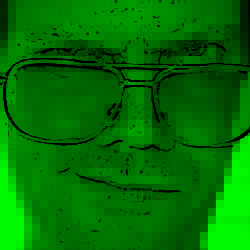Shady Characters has nudged the course of my life in recent years.
A few years back, some folks put together some resources to help folks learn the arcana of puzzlehunts. (Yes, there are mysteries, customs. Thinking about answer-extraction yields insights that let you skip parts. You are expected to recognize the six-dot Braille alphabet; you are not expected to know Braille contractions, eight-dot Braille symbols… That kind of thing.) Scott Royer had written an awesome puzzlehunt guide with a walkthrough for one puzzle. I was working at Google's engEDU team, hearing about Instructional Design and Theories of Learning all day. There are plenty of those Theories running around, but most agree: if you want someone to remember what you just taught them, give them a way to apply what they learned right away. So we wanted some more sample puzzles as exercises: nothing super-amazing, but something straightforward for Morse code, something for anagramming, something for indexing… Writing a puzzle with the only constraint "It should use Morse code" ain't so easy—you can do anything. If we had a theme, that would jump-start plenty of puzzles. But what theme?
I'd been reading the Shady Characters blog, reading about the history of punctuation. Most of these stories are of the form: over history, several symbols indicated the same thing. Before there were modern quotation marks, there were: different marks out in the margin, indented text with marks at the left edge; marks at the left edge with a different mark embedded in the text; different marks embedded in the text. But #'s story in the blog was different: # had been around roughly forever, but it meant different things over time and was called by different names.
So I used # as the theme for some sample exercise puzzles. Because # meant different things, there was still some variety. Several months later, there were quite a few puzzles. As the blog continued, more puzzle ideas resulted. Someone familiar with Swedish pointed out that # was a map symbol for a lumberyard. As you would expect, that inspired some lumber-ish puzzles.
Anyhow, when the book came out, I picked it up. It's a fun read; it's probably smoother to read the book than to pick your way through the blog. Usually, I'm a Kindle kind of guy, but I'm glad I got this book on paper. So far, most of the history of punctuation is tied up with the history of printing: scribes' marginalia, early typesetting. The physical book illustrates a lot of the type-ish things by using them itself; I suspect that wouldn't work so well on a Kindle. I read it over, got yet more puzzle ideas. But you might like the book even if you're not using it to get puzzle ideas.
